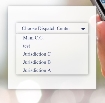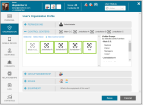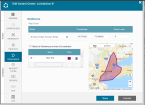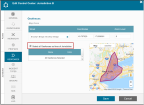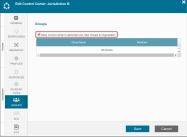Understanding Control Center Jurisdiction
If you wish to compartmentalize and manage different sections of your organization in separate Control Centers, you can do so by creating separate Control Centers.
Control Centers are designed to have limited jurisdiction to specific geographies (geofences), areas of expertise (Incident Types) or specific controlled users (Groups). Notwithstanding, no matter how many Control Centers you create - there will always be a Main Control Centers that has unlimited access to all the organization jurisdiction. The Main Control Centers operates as the trunk and the Secondary Centers are its branches.
For a short overview of the Main Control Centers functions see article click here.
Dispatcher / Supervisor Access
You can choose which Dispatcher/Operator has access to any of the Control Centers. Granting a Dispatcher access to the Main CC will allow that Dispatcher to view ALL Incidents in ALL areas and control ALL Users. Dispatchers with access to more than one CC will be prompted on login to choose which CC they want to login to.
Granting access of Dispatchers and Supervisors to Control Centers can be done either in the Dispatcher tab on the CC module:
or in the User Management module under the Control Centers tab:
Control Center Jurisdictions
When creating a new Control Center, you are asked to define which polygons, incident types and user groups are associated to the center. This article explains the significance of these configuration with regards to:
- Incident filtering
- User filtering
- Viewing responders on the map
- Creating new incidents
- Dispatching responders to incidents
Incident Filtering
You can define which incidents are accessible in a CC based on the COMBINATION of geographic areas (geofences) and professional domain (incident types).
When you select specific geofences and incident types, the only incidents that will appear in the CC are incidents that match both criteria.
For example:
CC Center A is configured to have jurisdiction over the "East London" polygon and over incident type "House Fire". Therefore, the dispatcher John, who is logged into CC A, will be able to view only "House Fire" incidents that are located in the "East London" predefined geofence.
If you wish the CC to view ALL areas and incident types then check the ALL checkbox. This will mean that also geofences and incident types created later will be added to this CC jurisdiction.
Additional Incidents that May Appear in the CC due to Associated Groups
Additional incidents that do not correspond to the area or incident type filtering may also appear in the CC due to a user/asset associated with both with the incident and the CC. If a user is a member of Group associated with the CC (see group association below) AND also appears as a contact (source, responder, etc) of the incident, then the SPECIFIC incident will also appear in the center.
This feature is configurable via system configurations, see below for the setting:
For example:
Jessica initiated an SOS call, which was created in the CC as incident no. 300. Jessica is a member of Group 10 which is associated with CC A. Although the incident was not located within one of the associated geofences, and incident type SOS isn't one of the authorized incident types, nevertheless, the incident will still be visible on CC A only because Jessica is a both the creator of incident no. 300 and is also a member of Group 10 which is associated to CC A.
To summarize:
The CC will display incidents where the incident type AND location match the CC jurisdiction OR any incident that was created by a user that is a member of one of the groups connected to the center.
User Group Filtering
Each CC has jurisdiction over Users that are members of Groups associated with the CC. Any Group can associated with multiple Control Centers and ALL Groups are visible to the Main CC.
For example:
Control Center A is configured to have jurisdiction over Groups 10, 20 and 30. The Dispatcher John, is authorized to login in to CC A. Therefore, when John logs into CC A – he will be able to view, dispatch and communicate with all Users in Groups 10, 20 and 30.
If you wish the Dispatcher to always have access to view any newly created Groups in the future - check "Allow CC to administer ALL User Groups".
Additional Users that May Appear in the CC due to Associated Incidents
Additional users that aren't usually associated with the CC may be visible if they happen to be users (Responders) in an incident is active that matches the criteria for incident filtering (as defined above).
For example:
Following the example above, (CC A can view Groups 10, 20, 30 and Dispatcher John has access to CC A) – Abe is not a member of any of these groups, yet he is a responder in an incident that matches the criteria for incident filtering (House Fire in East London). As long as the incident "House Fire" in "East London" is open, Abe will be visible to dispatchers logged into CC A.
Other Examples
John is a Dispatcher logged in to CC A – the CC has jurisdiction only over the "House Fire" incident type and "East London" polygon
- A new incident "Forest Fire" is created in the "East London" polygon. John didn't create the incident and none of the creators of the incident are in a group that fits the jurisdiction of CC A – In this case, John won't see the incident
- The incident is a "House Fire " outside the "East London" CC. John didn't create the incident and none of the contact persons in the incident are in a group that fits the joint jurisdiction of CC A – John won't see the incident
- The incident is a "House Fire" that happened outside the "East London" polygon, but John was the dispatcher who created that specific incident – John will see the incident AND any CC that has jurisdiction over John (via his group membership) will also be able to view this incident.
- The incident is a "Forest Fire" that is located outside the "East London" polygon. John did not open the Incident, but one of the creators of the incident (Caller/ Reporter etc.) is a member of a group that is under jurisdiction of CC A – John will see the incident
Other implications of the Control Center jurisdiction settings
Viewing Users on the Map
Only responders who belong to the groups under the jurisdiction of the Control Center will be seen on the map.
Additional responders that aren't associated with the secondary center may be visible if an incident is opened that fits the criteria for incident filtering (as defined above). These responders will only be seen while the incident is active.
Creating New Incidents
When creating new incidents in the Dispatcher, only incident types that are associated with the CC will be available for selection.
Dispatching Responders to Incidents
When dispatching responders to incidents, the only users that will be available for selection are users that are members of Groups associated with the center.
Control Center Access vs. Permission Profile
In order to allow more autonomy and flexibility in managing Control Centers while maintaining the privacy and security of each Center, you may grant access to Control Center while expanding or limiting specific functionalities of Dispatchers. In other words a Dispatcher with access to CC A may have more or less authority depending on the Dispatcher's permission profile in the system.
For example: Dispatcher John has access to CC A but has no permission to create Users or Assets.

